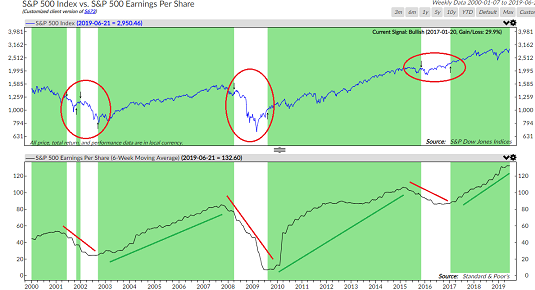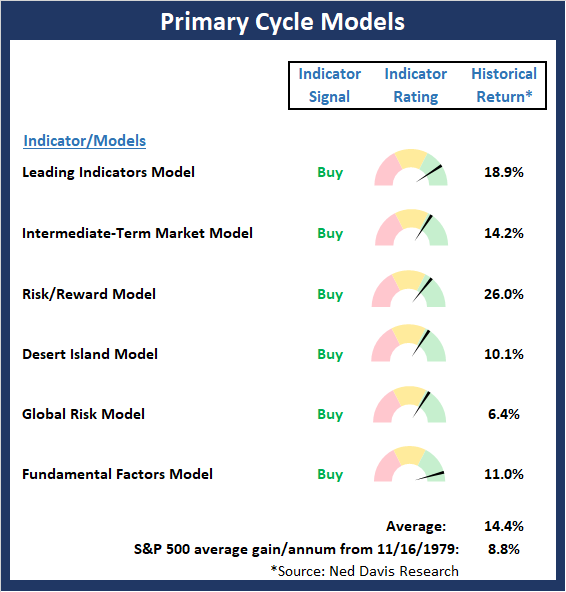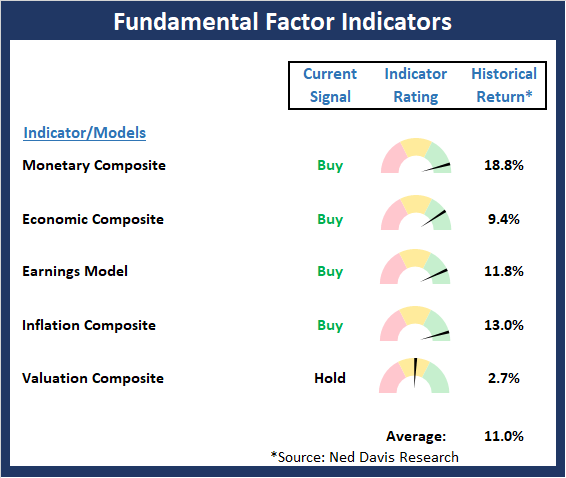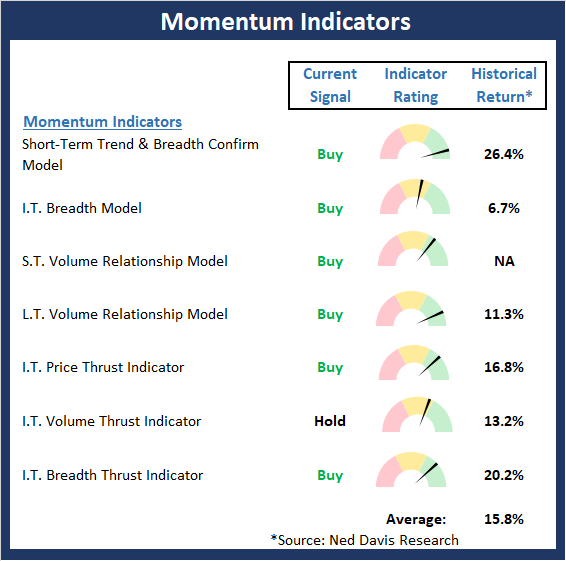Looking For A Way To Identify The Next Big Bear?
Let's review. The Fed is no longer the enemy. There is, at the very least, a cease-fire in the trade war between China and the good 'ol USofA. Rates are low. Inflation is nowhere to be found. Earnings will likely set a record this year. The U.S. economy continues to chug along. And if one takes a quick look at my Fundamental and Primary Cycle indicator boards, they will find an awful lot of green. As such, the bottom line is investors should probably continue to lean bullish here.
However, this continues to be a hated bull market. It seems all anybody can talk about these days is when the current run for the roses will end. Everybody and their grandmother is looking for the next recession. The next crisis. And the next big, bad, bear that will knock account values down 30-50%.
I get it. Yes, the current bull market, which has not technically experienced a 20% decline in more than a decade (although December's dance to the downside got very close!), will end at some point. I understand that there is a global economic slowdown at work. I see there are headwinds, both real and imagined. And it is true that try as they might, the politicians and global central bankers may not be able to outlaw the business cycle.
So, yes, at some point, one of the longest bull markets on record (although definitely not one of the strongest) will end and the bears will enjoy a year or so in the sun. Thus, an important question for investors, financial advisors, and portfolio managers alike will need to answer is, how do you tell when the bull has run its course.
Or more importantly, how can you tell when the next correction of 10% turns into a 20% move, which then proceeds to become a really big, really bad bear?
How Can You Tell If A Big, Bad Bear is Coming?
There are lots of ideas on the subject, but this morning I'd like to offer up a method based on an old-fashioned concept - earnings.
It is said that earnings are the lifeblood of the stock market. And since the market is purported to be a discounting mechanism of future expectations, if a company's earnings are rising, it follows that the price of the underlying stock should rise as well. And vice versa.
So, it would be logical to assume that if earnings on the S&P 500 began to fall, the risks of a meaningful correction would increase. And if earnings on the S&P fell a lot, it would follow that the risks of a really big, really bad bear market would also rise.
While this concept makes loads of sense (well, to me anyway), a career in this business will teach you that logic doesn't always work when dealing with major turns in the stock market. But the good news is that for the last thirty years, directional changes in the level of S&P 500 EPS has indeed been a pretty decent predictor of nastiness in the stock market.
One Answer: Watch Earnings
Here's the way the idea works. Start with a 6-week moving average of S&P 500 earnings per share. Next, pay attention to when the moving average falls from its most recent peak by 10%. According to the analysts at Ned Davis Research, this has been a good indicator of potential problems for the overall market.
The chart below illustrates the idea. I've gone back to 2000 and circled in red the times when S&P earnings have fallen by 10% or more.

View Larger Chart Online
Source: Ned Davis Research Group
As you can see, this concept would have done a very nice job in keeping you out of harm's way during the dark days of 2001 and 2002, the 2008-09 financial crisis, and then again, when things got sloppy in late 2015.
One could quibble with the 2015 signal and suggest that the mini bear that ensued wasn't worth trying to sidestep. However, we should remember that during this period it was the debacle in oil. The dramatic decline in the oil patch hit the sector's earnings so hard that it wound up spilling over into the index, which, in turn, caused the so-called earnings recession.
To be sure, no indicator/model is ever perfect. So, the 2015-16 period was an example of a "yea-but" for this particular indicator.
However, the computers at NDR show that a hypothetical test of this approach would have worked pretty well over the last thirty years. For example, since 1990, NDR tells us that when this earnings signal was positive, the S&P 500 gained at an annualized rate of +12.2% per year. And when the indicator was negative, the S&P lost ground at a rate of -12.1% per year.
In my book, this is a performance spread that is worth paying attention to!
So, the question you might be asking is, what is this indicator saying now? Well, given that the 6-week average of S&P 500 EPS is sitting at an all-time high, the indicator is a LONG way from a sell signal. And from my seat, this means that unless something occurs to cause earnings to fall rapidly, investors, financial advisors, and portfolio managers alike might want to continue to stay seated on the bull train.
Weekly Market Model Review
Now let's turn to the weekly review of my favorite indicators and market models...
The State of My Favorite Big-Picture Market Models
As I wrote last week, there can be little argument that this remains a news-driven environment. I also noted that there isn't an effective way to effectively "model" this type of environment. Yet at the same time, I believe that the big-picture "backdrop" provides a clue about what to expect when the news driven environment ends. And with two models on the Primary Cycle board moving to positive readings, my takeaway is to lean bullish through all the noise.
This week's mean percentage score of my 6 favorite models improved to 73.5% from 62.9% last week (Prior readings: 65.4%, 62.9%, 60%, 60%, 72.5%, 81.1%) while the median also rose to 68.5% versus 66.3% last week (Prior readings: 71.3%, 68.8%, 62.5%, 62.5%, 80.0% 82.5%, 86.7%).

View My Favorite Market Models Online
The State of the Fundamental Backdrop
I believe the message from the Fundamental and Primary Cycle boards is to give the bulls the benefit of any doubt and to buy the inevitable dips.

View Fundamental Indicator Board Online
The State of the Trend
Although the major indices moved sideways last week, nothing changed in terms of our view on the overall trend, which is in pretty good shape. Sure, a surprise on the news front could certainly cause traders to explore the current range. However, we continue to believe that the dips should be bought for the time being.

View Trend Indicator Board Online
The State of Internal Momentum
The Momentum board continues to sport a lot of green signals. However, I would not label the current momentum environment as super strong. No, most of the intermediate- and longer-term readings are "just okay" at this point in the game. Which, again, tells us to lean bullish and to be ready for pullbacks.

View Momentum Indicator Board Online
The State of the "Trade"
The Early Warning board is largely neutral at this time with neither team holding much of an edge. In this environment, I've found it best to stay with the prevailing trend but as I've been saying today, be ready for the next pullback.

View Early Warning Indicator Board Online
Thought For The Day:
The quieter you become, the more you can hear. Ram Dass
Wishing you green screens and all the best for a great day,

David D. Moenning
Founder, Chief Investment Officer
Heritage Capital Research
HCR Focuses on a Risk-Managed Approach to Investing
What Risk Management Can and Cannot Do
Disclosures
At the time of publication, Mr. Moenning held long positions in the following securities mentioned: None - Note that positions may change at any time.
Leading Indicators Model: A group of indicators that have historically shown tendencies to lead the market at major turning points.
Intermediate-Term Market Model: A composite model (model of models) focused on trend and momentum indicators which has been designed to provide identify intermediate-term trading opportunities.
Risk/Reward Model: A model-of-models intended to provide an overall view of the state of the risk/reward environment. The model includes tape, monetary, and sentiment indicators as well as 7 big-picture market model readings.
Desert Island Model: If I was stranded on a desert island with access to only one market model to manage money with, this would be the model. The model is a comprehensive model-of-models comprised of trend, momentum, mean reversion, economic, monetary, sentiment, and factor-based indicators/models.
External Factors Model: A model-of-models designed to provide a reading on the "macro state" of the market environment. The model is comprised of indicators/models in the areas of various index yields, industrial production, investors sentiment, and historic volatility.
Short-Term Trend-and-Breadth Signal Explained: History shows the most reliable market moves tend to occur when the breadth indices are in gear with the major market averages. When the breadth measures diverge, investors should take note that a trend reversal may be at hand. This indicator incorporates NDR's All-Cap Dollar Weighted Equity Series and A/D Line. From 1998, when the A/D line is above its 5-day smoothing and the All-Cap Equal Weighted Equity Series is above its 25-day smoothing, the equity index has gained at a rate of +32.5% per year. When one of the indicators is above its smoothing, the equity index has gained at a rate of +13.3% per year. And when both are below, the equity index has lost +23.6% per year.
Channel Breakout System Explained: The short-term and intermediate-term Channel Breakout Systems are modified versions of the Donchian Channel indicator. According to Wikipedia, "The Donchian channel is an indicator used in market trading developed by Richard Donchian. It is formed by taking the highest high and the lowest low of the last n periods. The area between the high and the low is the channel for the period chosen."
Intermediate-Term Trend-and-Breadth Signal Explained: This indicator incorporates NDR's All-Cap Dollar Weighted Equity Series and A/D Line. From 1998, when the A/D line is above its 45-day smoothing and the All-Cap Equal Weighted Equity Series is above its 45-day smoothing, the equity index has gained at a rate of +17.6% per year. When one of the indicators is above its smoothing, the equity index has gained at a rate of +6.5% per year. And when both are below, the equity index has lost -1.3% per year.
Cycle Composite Projections: The cycle composite combines the 1-year Seasonal, 4-year Presidential, and 10-year Decennial cycles. The indicator reading shown uses the cycle projection for the upcoming week.
Trading Mode Indicator: This indicator attempts to identify whether the current trading environment is "trending" or "mean reverting." The indicator takes the composite reading of the Efficiency Ratio, the Average Correlation Coefficient, and Trend Strength models.
Volume Relationship Models: These models review the relationship between "supply" and "demand" volume over the short- and intermediate-term time frames.
Price Thrust Model Explained: This indicator measures the 3-day rate of change of the Value Line Composite relative to the standard deviation of the 30-day average. When the Value Line's 3-day rate of change have moved above 0.5 standard deviation of the 30-day average ROC, a "thrust" occurs and since 2000, the Value Line Composite has gained ground at a rate of +20.6% per year. When the indicator is below 0.5 standard deviation of the 30-day, the Value Line has lost ground at a rate of -10.0% per year. And when neutral, the Value Line has gained at a rate of +5.9% per year.
Volume Thrust Model Explained: This indicator uses NASDAQ volume data to indicate bullish and bearish conditions for the NASDAQ Composite Index. The indicator plots the ratio of the 10-day total of NASDAQ daily advancing volume (i.e., the total volume traded in stocks which rose in price each day) to the 10-day total of daily declining volume (volume traded in stocks which fell each day). This ratio indicates when advancing stocks are attracting the majority of the volume (readings above 1.0) and when declining stocks are seeing the heaviest trading (readings below 1.0). This indicator thus supports the case that a rising market supported by heavier volume in the advancing issues tends to be the most bullish condition, while a declining market with downside volume dominating confirms bearish conditions. When in a positive mode, the NASDAQ Composite has gained at a rate of +38.3% per year, When neutral, the NASDAQ has gained at a rate of +13.3% per year. And when negative, the NASDAQ has lost at a rate of -14.279% per year.
Breadth Thrust Model Explained: This indicator uses the number of NASDAQ-listed stocks advancing and declining to indicate bullish or bearish breadth conditions for the NASDAQ Composite. The indicator plots the ratio of the 10-day total of the number of stocks rising on the NASDAQ each day to the 10-day total of the number of stocks declining each day. Using 10-day totals smooths the random daily fluctuations and gives indications on an intermediate-term basis. As expected, the NASDAQ Composite performs much better when the 10-day A/D ratio is high (strong breadth) and worse when the indicator is in its lower mode (weak breadth). The most bullish conditions for the NASDAQ when the 10-day A/D indicator is not only high, but has recently posted an extreme high reading and thus indicated a thrust of upside momentum. Bearish conditions are confirmed when the indicator is low and has recently signaled a downside breadth thrust. In positive mode, the NASDAQ has gained at a rate of +22.1% per year since 1981. In a neutral mode, the NASDAQ has gained at a rate of +14.5% per year. And when in a negative mode, the NASDAQ has lost at a rate of -6.4% per year.
Short-Term Overbought/sold Indicator: This indicator is the current reading of the 14,1,3 stochastic oscillator. When the oscillator is above 80 and the %K is above the %D, the indicator gives an overbought reading. Conversely, when the oscillator is below 20 and %K is below its %D, the indicator is oversold.
Intermediate-Term Overbought/sold Indicator: This indicator is a 40-day RSI reading. When above 57.5, the indicator is considered overbought and wnen below 45 it is oversold.
Mean Reversion Model: This is a diffusion model consisting of five indicators that can produce buy and sell signals based on overbought/sold conditions.
VIX Indicator: This indicators looks at the current reading of the VIX relative to standard deviation bands. When the indicator reaches an extreme reading in either direction, it is an indication that a market trend could reverse in the near-term.
Short-Term Sentiment Indicator: This is a model-of-models composed of 18 independent sentiment indicators designed to indicate when market sentiment has reached an extreme from a short-term perspective. Historical analysis indicates that the stock market's best gains come after an environment has become extremely negative from a sentiment standpoint. Conversely, when sentiment becomes extremely positive, market returns have been subpar.
Intermediate-Term Sentiment Indicator: This is a model-of-models composed of 7 independent sentiment indicators designed to indicate when market sentiment has reached an extreme from a intermediate-term perspective. Historical analysis indicates that the stock market's best gains come after an environment has become extremely negative from a sentiment standpoint. Conversely, when sentiment becomes extremely positive, market returns have been subpar.
Long-Term Sentiment Indicator: This is a model-of-models composed of 6 independent sentiment indicators designed to indicate when market sentiment has reached an extreme from a long-term perspective. Historical analysis indicates that the stock market's best gains come after an environment has become extremely negative from a sentiment standpoint. Conversely, when sentiment becomes extremely positive, market returns have been subpar.
Absolute Monetary Model Explained: The popular cliche, "Don't fight the Fed" is really a testament to the profound impact that interest rates and Fed policy have on the market. It is a proven fact that monetary conditions are one of the most powerful influences on the direction of stock prices. The Absolute Monetary Model looks at the current level of interest rates relative to historical levels and Fed policy.
Relative Monetary Model Explained: The "relative" monetary model looks at monetary indicators relative to recent levels as well as rates of change and Fed Policy.
Economic Model Explained: During the middle of bull and bear markets, understanding the overall health of the economy and how it impacts the stock market is one of the few truly logical aspects of the stock market. When our Economic model sports a "positive" reading, history (beginning in 1965) shows that stocks enjoy returns in excess of 21% per year. Yet, when the model's reading falls into the "negative" zone, the S&P has lost nearly -25% per year. However, it is vital to understand that there are times when good economic news is actually bad for stocks and vice versa. Thus, the Economic model can help investors stay in tune with where we are in the overall economic cycle.
Inflation Model Explained: They say that "the tape tells all." However, one of the best "big picture" indicators of what the market is expected to do next is inflation. Simply put, since 1962, when the model indicates that inflationary pressures are strong, stocks have lost ground. Yet, when inflationary pressures are low, the S&P 500 has gained ground at a rate in excess of 13%. The bottom line is inflation is one of the primary drivers of stock market returns.
Valuation Model Explained: If you want to get analysts really riled up, you need only to begin a discussion of market valuation. While the question of whether stocks are overvalued or undervalued appears to be a simple one, the subject is actually extremely complex. To simplify the subject dramatically, investors must first determine if they should focus on relative valuation (which include the current level of interest rates) or absolute valuation measures (the more traditional readings of Price/Earnings, Price/Dividend, and Price/Book Value). We believe that it is important to recognize that environments change. And as such, the market's focus and corresponding view of valuations are likely to change as well. Thus, we depend on our Valuation Models to help us keep our eye on the ball.
Disclosures
NOT INVESTMENT ADVICE. The opinions and forecasts expressed herein are those of Mr. David Moenning and Heritage Capital Research and may not actually come to pass. The opinions and viewpoints regarding the future of the markets should not be construed as recommendations. The analysis and information in this report is for informational purposes only. No part of the material presented in this report is intended as an investment recommendation or investment advice. Neither the information nor any opinion expressed constitutes a solicitation to purchase or sell securities or any investment program.
Any investment decisions must in all cases be made by the reader or by his or her investment adviser. Do NOT ever purchase any security without doing sufficient research. There is no guarantee that the investment objectives outlined will actually come to pass. All opinions expressed herein are subject to change without notice. Neither the editor, employees, nor any of their affiliates shall have any liability for any loss sustained by anyone who has relied on the information provided.
Mr. Moenning of Heritage Capital Research is an investment adviser representative of Eastsound Capital Advisors, LLC, a registered investment advisor. The adviser may not transact business in states where it is not appropriately registered, excluded or exempted from registration. Individualized responses to persons that involve either the effecting of transaction in securities, or the rendering of personalized investment advice for compensation, will not be made without registration or exemption.
Mr. Moenning and Heritage Capital Research may at times have positions in the securities referred to and may make purchases or sales of these securities while publications are in circulation. Positions may change at any time.
The analysis provided is based on both technical and fundamental research and is provided "as is" without warranty of any kind, either expressed or implied. Although the information contained is derived from sources which are believed to be reliable, they cannot be guaranteed.
The author neither endorses nor warrants the content of this site, any embedded advertisement, or any linked resource. The author or his managed funds may hold either long or short positions in the referenced securities. Republication rights must be expressly granted by author in writing.
Investments in equities carry an inherent element of risk including the potential for significant loss of principal. Past performance is not an indication of future results.

